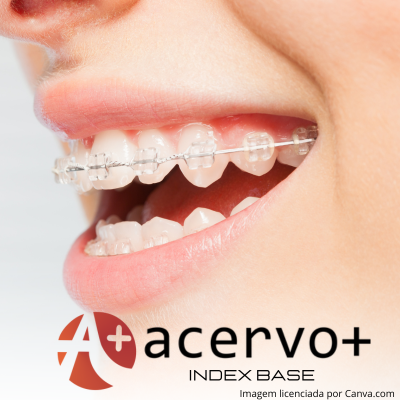Evidências atuais sobre o tratamento da má oclusão de Classe II com alinhadores ortodônticos
##plugins.themes.bootstrap3.article.main##
Resumo
Objetivo: Identificar e avaliar as evidências atuais sobre o tratamento de má oclusão de Classe II com alinhadores ortodônticos. Métodos: Foi realizada uma revisão integrativa na base de dados do PubMed, baseada nos termos “Invisible Aligners OR Invisalign OR Invisible Orthodontics OR Clear Aligners AND Class II”, sendo selecionados os artigos publicados nos últimos 5 anos (de janeiro de 2019 a janeiro de 2024), a partir da leitura de títulos, resumos ou texto completo. Resultados: A busca inicial resultou em 1586 artigos. Após aplicação dos critérios de elegibilidade foram incluídos 15 artigos nesse trabalho. As três técnicas mais utilizadas para tratar Classe II com alinhadores ortodônticos, foram distalização sequencial de molares superiores, elásticos intermaxilares e alinhadores com avanço mandibular. Alinhadores ortodônticos produziram menos extrusão de molares superiores, melhor controle do plano oclusal, menor incidência de reabsorção radicular e fenestração óssea. Foi verificada diferença entre os resultados do planejamento virtual e os resultados pós-tratamento, sendo indicadas fases de refinamento para obtenção de resultados satisfatórios. Considerações finais: As evidências disponíveis indicam que é possível tratar má oclusão de Classe II com alinhadores ortodônticos.
##plugins.themes.bootstrap3.article.details##
Copyright © | Todos os direitos reservados.
A revista detém os direitos autorais exclusivos de publicação deste artigo nos termos da lei 9610/98.
Reprodução parcial
É livre o uso de partes do texto, figuras e questionário do artigo, sendo obrigatória a citação dos autores e revista.
Reprodução total
É expressamente proibida, devendo ser autorizada pela revista.
Referências
2. BALBONI A, et al. Vertical effects of distalization protocol with clear aligners in class ii patients: a prospective study. Minerva Dental and Oral Science, 2023; 72(6): 291-7.
3. CHEN H, et al. Changes of maxillary central incisor and alveolar bone in Class II Division 2 nonextraction treatment with a fixed appliance or clear aligner: A pilot cone-beam computed tomography study. American Journal of Orthodontics and Dentofacial Orthopedics, 2023; 163(4): 509-19.
4. CORDEIRO M, et al. Alinhador ortodôntico (Invisalign®): Uma realidade. Revisão de literatura. RGS, 2019; 21: 47-53.
5. DIANISKOVA S, et al. Treatment of mild Class II malocclusion in growing patients with clear aligners versus fixed multibracket therapy: A retrospective study. Orthodontics and Craniofacial Research, 2022; 25(1): 96-102.
6. DJEU G, et al. Outcome assessment of invisalign and traditional orthodotics treatment compared with the American Board of Othodontics objective grading system. American Journal of Orthodontics and Dentofacial Orthopedics, 2005; 128(3): 292-8.
7. EL-BIALY T. The effect of high-frequency vibration on tooth movement and alveolar bone in non-growing skeletal class II high angle orthodontic patients: Case series. Dentistry Journal, 2020; 8(4): 110.
8. NANDA R. Estratégias Biomecâmicas e Estéticas em Ortodontia. 2ª ed. Brasil: Elsivier, 2015; 632.
9. HOPIA H, et al. Reviewing the methodology of an integrative review. Scandinavian Journal of Caring Sciences, 2016; 30(4): 662-69.
10. JANSON G, et al. Correction of class II malocclusion with class II elastics: a systematic review. Am J Orthod Dentofac Orthop., 2013; 143: 383-92.
11. LI L, et al. Maxillary molar distalization with a 2-week clear aligner protocol in patients with Class II malocclusion: A retrospective study. American Journal of Orthodontics and Dentofacial Orthopedics, 2023; 164(1): 123-30.
12. LIAW JJ, et al. Torque recovery of the maxillary incisors with a modified double J retractor in a Class II division 2 case treated with clear aligners. The Angle Orthodontist, 2023; 93(3): 357-71.
13. LIONE R, et al. Effects of pendulum appliance versus clear aligners in the vertical dimension during Class II malocclusion treatment: a randomized prospective clinical trial. BMC Oral Health, 2022; 22(1): 41.
14. LIU X, et al. Effects of upper-molar distalization using clear aligners in combination with Class II elastics: a three-dimensional finite element analysis. BMC Oral Health, 2022; 22(1).
15. MCNAMARA JR JA. Components of Class II malocclusion in children 8–10 years of age. Angle Orthod, 1981; 51: 177-202.
16. MORO A, et al. Tratamento da Classe II com Invisalign. Orthod. Sci. Pract, 2021; 107-99.
17. PATTERSON BD, et al. Class II malocclusion correction with Invisalign: Is it possible? Am J Orthod Dentofacial Orthop,2021; 159(1): 41-48.
18. RAVERA S, et al. Short term dentoskeletal effects of mandibular advancement clear aligners in Class II growing patients. A prospective controlled study according to STROBE Guidelines. European Journal of Paediatric Dentistry, 2021; 22(2): 119-24.
19. RONGO R, et al. Class II Malocclusion in Adult Patients: What Are the Effects of the Intermaxillary Elastics with Clear Aligners? A Retrospective Single Center One-Group Longitudinal Study. Journal of Clinical Medicine, 2022; 11(24): 7333.
20. RUSSELL CL. An overview of the integrative research review. Prog Transplant, 2005; 15: 8-13.
21. SCHNAIDER F. Alinhadores transparentes Invisalign® na distalização: Uma revisão sistemática. Dissertação - (Mestrado em Odontologia). Instituto Universitário de Ciências da Saúde. Granda, 2020; 13.
22. SCHUPP W, et al. Class II correction with the Invisalign system. J Clin Orthod, 2010; 44: 28-35.
23. SIMON M, et al. Treatment outcome and efficacy of an aligner technique--regarding incisor torque, premolar derotation and molar distalization. BMC Oral Health, 2014; 14: 68-75.
24. TAFFAREL IA, et al. Distalization of maxillary molars with Invisalign aligners in nonextraction patients with Class II malocclusion. American Journal of Orthodontics and Dentofacial Orthopedics, 2022; 162(4): 176-82.
25. THIESEN G. Abordagem para o retratamento de Classe II com distalização intrabucal. Rev Clín Ortod Dental Press, 2011; 10: 66-74.
26. WANG Q, et al. Biomechanical analysis of effective mandibular en-masse retraction using Class II elastics with a clear aligner: a finite element study. Progress in Orthodontics, 2022; 23(1): 23.
27. WEIR T. Clear aligners in orthodontic treatment. Australian Dental Journal, 2017; 62: 58-62.
28. WHEELER TT. Orthodontic clear aligner treatment. Semin Orthod, 2017; 23: 83-89.
29. YAN X, et al. Effectiveness of clear aligners in achieving proclination and intrusion of incisors among Class II division 2 patients: a multivariate analysis. Progress in Orthodontics, 2023; 24(1).

